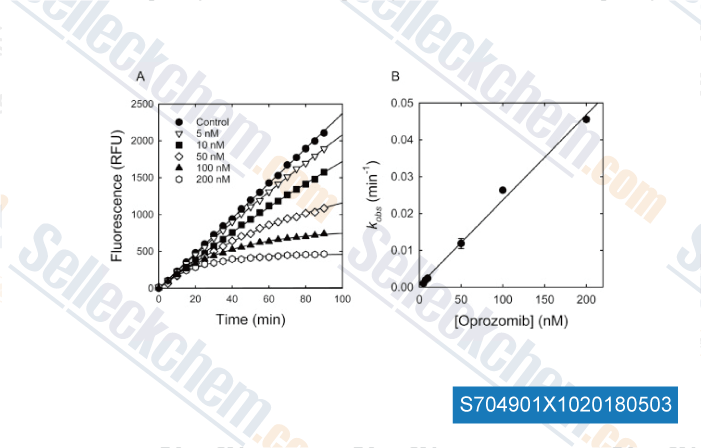|
Toll Free: (877) 796-6397 -- USA and Canada only -- |
Fax: +1-832-582-8590 Orders: +1-832-582-8158 |
Tech Support: +1-832-582-8158 Ext:3 Please provide your Order Number in the email. |
Technical Data
| Formula | C25H32N4O7S |
||||||||||
| Molecular Weight | 532.61 | CAS No. | 935888-69-0 | ||||||||
| Solubility (25°C)* | In vitro | DMSO | 100 mg/mL (187.75 mM) | ||||||||
| Water | Insoluble | ||||||||||
| Ethanol | Insoluble | ||||||||||
| In vivo (Add solvents to the product individually and in order) |
|
||||||||||
|
* <1 mg/ml means slightly soluble or insoluble. * Please note that Selleck tests the solubility of all compounds in-house, and the actual solubility may differ slightly from published values. This is normal and is due to slight batch-to-batch variations. * Room temperature shipping (Stability testing shows this product can be shipped without any cooling measures.) |
|||||||||||
Preparing Stock Solutions
Biological Activity
| Description | Oprozomib is an orally bioavailable inhibitor for CT-L activity of 20S proteasome β5/LMP7 with IC50 of 36 nM/82 nM. Phase 1/2. | ||||
|---|---|---|---|---|---|
| Targets |
|
||||
| In vitro | The anti-MM activity of Oprozomib is associated with activation of caspase-8, caspase-9, caspase-3, and PARP, as well as inhibition of migration of MM cells and angiogenesis. [2] | ||||
| In vivo | Oprozomib is demonstrated an absolute bioavailability of up to 39% in rodents and dogs. It is well tolerated with repeated oral administration at doses resulting in >80% proteasome inhibition in most tissues and elicited an antitumor response in multiple human tumor xenograft and mouse syngeneic models [1]. |
Protocol (from reference)
| Kinase Assay:[3] |
|
|---|---|
| Cell Assay:[2] |
|
| Animal Study:[1] |
|
References
|
Customer Product Validation

-
Data from [Data independently produced by , , Archives of Biochemistry and Biophysics, 2018, 639:52-58]
Selleck's Oprozomib has been cited by 21 publications
| Dual inhibition of HSF1 and DYRK2 impedes cancer progression [ Biosci Rep, 2023, 43(1)BSR20222102] | PubMed: 36622366 |
| Proteasome inhibition as a therapeutic target for the fungal pathogen Cryptococcus neoformans [ Microbiol Spectr, 2023, 11(5):e0190423] | PubMed: 37750732 |
| Proteasome inhibition as a therapeutic target for the fungal pathogen Cryptococcus neoformans [ Microbiol Spectr, 2023, 10.1128/spectrum.01904-23] | PubMed: 37750732 |
| Mechanism of action of hepatitis B virus S antigen transport-inhibiting oligonucleotide polymer, STOPS, molecules [ Mol Ther Nucleic Acids, 2022, 27:335-348] | PubMed: 35024245 |
| Oral Proteasomal Inhibitors Ixazomib, Oprozomib, and Delanzomib Upregulate the Function of Organic Anion Transporter 3 (OAT3): Implications in OAT3-Mediated Drug-Drug Interactions [ Pharmaceutics, 2021, 13(3)314] | PubMed: 33670955 |
| Crosstalk between HSPA5 arginylation and sequential ubiquitination leads to AKT degradation through autophagy flux. [ Autophagy, 2020, 10.1080/15548627.2020.1740529] | PubMed: 32164484 |
| A Patient-Derived Cell Atlas Informs Precision Targeting of Glioblastoma [ Cell Rep, 2020, 32(2):107897] | PubMed: 32668248 |
| Proteasome inhibitors and Smac mimetics cooperate to induce cell death in Diffuse Large B-cell Lymphoma by stabilizing NOXA and triggering mitochondrial apoptosis. [ Int J Cancer, 2020, 10.1002/ijc.32976] | PubMed: 32170726 |
| Prolonged unfolded protein reaction is involved in the induction of chronic myeloid leukemia cell death upon oprozomib treatment [ Cancer Sci, 2020, 112(1):133-143] | PubMed: 33067904 |
| Charge transfer reaction mechanisms of epoxyketone and boronated peptides at glassy carbon and boron doped diamond electrodes [ J Electroanal Chem (Lausanne), 2020, 878:114733] | PubMed: 33020701 |
RETURN POLICY
Selleck Chemical’s Unconditional Return Policy ensures a smooth online shopping experience for our customers. If you are in any way unsatisfied with your purchase, you may return any item(s) within 7 days of receiving it. In the event of product quality issues, either protocol related or product related problems, you may return any item(s) within 365 days from the original purchase date. Please follow the instructions below when returning products.
SHIPPING AND STORAGE
Selleck products are transported at room temperature. If you receive the product at room temperature, please rest assured, the Selleck Quality Inspection Department has conducted experiments to verify that the normal temperature placement of one month will not affect the biological activity of powder products. After collecting, please store the product according to the requirements described in the datasheet. Most Selleck products are stable under the recommended conditions.
NOT FOR HUMAN, VETERINARY DIAGNOSTIC OR THERAPEUTIC USE.
